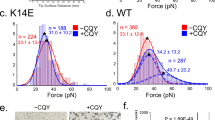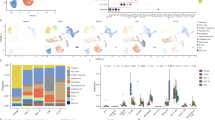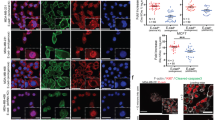Abstract
E-cadherin function is thought to be impaired in epithelial cancer. To investigate the alterations in E-cadherin associated with cytoplasmic molecules including α-catenin, β-catenin, γ-catenin, p120CAS, and IQGAP1 in various endometrial cancers with different degree of differentiation, we examined the localization and expression of E-cadherin and cytoplasmic molecules in 30 cases of both well and poorly differentiated endometrioid adenocarcinomas, using immunofluorescence and immunoblotting techniques. E-cadherin and cytoplasmic molecules demonstrated linear staining at the cell boundaries in normal endometrium. In all 20 cases with well differentiated adenocarcinomas, α-catenin and IQGAP1 disappeared from the cell adhesive sites, but other cytoplasmic molecules were co-localized with E-cadherin along the cell boundaries. In all 10 cases with poorly differentiated adenocarcinomas, E-cadherin and cytoplasmic molecules accumulated as large aggregates along cell adhesive sites, and the localization of IQGAP1 differed from those of other cytoplasmic molecules. The expression of these molecules in all 20 cases with well differentiated adenocarcinomas decreased or was lost in Triton-insoluble fraction, in comparison with the findings for all cases with normal endometrium or poorly differentiated adenocarcinomas. These results suggested that each alteration in E-cadherin associated with cytoplasmic molecules may play a different role in E-cadherin dysfunction between well and poorly differentiated adenocarcinomas. © 2000 Cancer Research Campaign
Similar content being viewed by others
Article PDF
Change history
16 November 2011
This paper was modified 12 months after initial publication to switch to Creative Commons licence terms, as noted at publication
References
Aberle H, Schwartz H and Kemler R (1996) Cadherin-catenin complex: protein interactions and their implications for cadherin function. J Cell Biochem 61: 514–523
Becher KF, Atkinson MJ, Reich U, Becker I, Nekarda H, Siewert JR and Hofler H (1994) E-cadherin gene mutations provide clues to diffuse type gastric carcinomas. Cancer Res 54: 3845–3852
Behrens JK, Vakaet L, Friis R, Winterhager E, Van Roy F, Mareel MM and Birchmeier W (1993) Loss of epithelial differentiation and gain of invasiveness correlates with tyrosine phosphorylation of the E-cadherin/β-catenin complex in cells transformed with a temperature-sensitive v-SRCK gene. J Cell Biol 120: 757–766
Bradford MM (1976) A rapid and sensitive method for the quantitation of microgram quantities of protein utilizing the principle of protein-dye binding. Anal Biochem 72: 248–454
Braga VM, Machesky LM, Hall A and Hotchin NA (1997) The small GTPases Rho and Rac are required for the establishment of cadherin-dependent cell–cell contacts. J Cell Biol 137: 1421–1431
Creasman WT (1993) Prognostic significance of hormone receptors in endometrial cancer. Cancer 71: 1467–1470
Daniel JM and Reynolds AB (1995) The tyrosine kinase substrate p 120cas binds directly to E-cadherin but not to the adenomatous polyposis coli protein, β, or, α-catenin. Mol Cell Biol 15: 4819–4824
Dorudi S, Sheffield JP, Poulsom R, Northover JM and Hart IR (1993) E-cadherin expression in colorectal cancer. An immunocytochemical and in situ hybridization study. Am J Pathol 142: 981–986
Drubin DG and Nelson WJ (1996) Origins of cell polarity. Cell 84: 335–344
Gumbiner BM (1996) Cell adhesion: the molecular basis of tissue architecture and morphogenesis. Cell 84: 345–357
Hirohashi S (1998) Inactivation of the E-cadherin-mediated cell adhesion system in human cancers. Am J Pathol 153: 333–339
Jou TS and Nelson WJ (1998) Effects of regulated expression of mutant RhoA and Rac1 small GTPases on the development of epithelial (MDCK) cell polarity. J Cell Biol 142: 85–100
Kauppila A, Kujansuu E and Vihko R (1982) Cytosol estrogen and progestin receptors in endometrial carcinoma of patients treated with surgery, radiotherapy, and progestin. Clinical correlates. Cancer 50: 2157–2162
Kinch MS, Clark GJ, Der CJ and Burridge K (1995) Tyrosine phosphorylation regulates the adhesions of ras-transformed breast epithelia. J Cell Biol 130: 461–471
Kinssela AR, Green B, Lepts GC, Hill CL, Bowie G and Taylor BA (1992) The role of the cell–cell adhesion molecule E-cadherin in large bowel tumour cell invasion and metastasis. Br J Cancer 67: 804–809
Kobayashi K, Sagae S, Nishioka Y, Tokino T and Kudo R (1999) Mutations of the β-catenin gene in endometrial carcinomas. Jpn J Cancer Res 90: 55–59
Kuroda S, Fukata M, Fujii K, Nakamura T, Izawa I and Kaibuchi K (1997) Regulation of cell–cell adhesion of MDCK cells by Cdc42 and Rac1 small GTPases. Biochem Biophys Res Commun 240: 430–435
Kuroda S, Fukata M, Nakagawa M, Fujii K, Nakamura T, Ookubo T, Izawa I, Nagase T, Nomura N, Tani H, Shoji I, Matsuura Y, Yonehara S and Kaibuchi K (1998) Role of IQGAP1, a target of the small GTPases Cdc42 and Rac1, in regulation of E-cadherin-mediated cell–cell adhesion. Science 281: 832–835
Mareel MM, Vleminckx K, Vermeulen S, Yan G, Bracke M and Van Roy F (1994) Downregulation in vivo of the invasion-suppressor molecule E-cadherin in experimental and clinical cancer. In: Molecular and Cellular Basis for Cell to Cell Interaction: Its Significance in Cancer, Hirohashi S Moses HL Ruoslahti E Sugimura T Takeichi M Terada M (eds). pp. 63–80 Proceedings of the 24th International Symposium of the Princess Takamatsu Cancer Research Fund. The Princeton Scientific Publishing Co, Inc: Princeton, New Jersey, USA
Matsui S, Shiozaki H, Inoue M, Tamura S, Doki Y, Kadowaki T, Iwazawa T, Shimaya K, Nagafuchi A, Tsukita S and Mori T (1994) Immunohistochemical evaluation of alpha-catenin expression in human gastric cancer. Virchows Arch [A] Pathol Anat Histopathol 424: 375–381
Matsuyoshi N, Hamaguchi M, Taniguchi S, Nagafuchi A, Tsukita S and Takeichi M (1992) Cadherin-mediated cell-cell adhesion is perturbed by v-src tyrosine phosphorylation in metastatic fibroblasts. J Cell Biol 118: 703–714
Mayer B, Johnson JP, Leitl F, Jauch KW, Heiss MM, Schildberg FW, Birchmeier W and Funke I (1993) E-cadherin expression in primary and metastatic gastric cancer: down-regulation correlates with cellular dedifferentiation and glandular disintegration. Cancer Res 53: 1690–1695
Miyamoto S, Teramoto H, Coso OA, Gutkind JS, Burbelo PD, Akiyama SK and Yamada KM (1995) Integrin function: molecular hierarchies of cytoskeletal and signaling molecules. J Cell Biol 131: 791–805
Morin PJ, Sparks AB, Korinek V, Barker N, Clevers H, Vogelstein B and Kinzler KW (1997) Activation of β-catenin-Tcf signaling in colon cancer by mutations in β-catenin or APC. Science 275: 1787–1790
Nagafuchi A, Takeichi M and Tsukita S (1991) The 102 kd cadherin-associated protein: similarity to vinculin and posttranscriptional regulation of expression. Cell 65: 849–857
Oka H, Shiozaki H, Kobayashi K, Tahara H, Tamura S, Miyata M, Doki Y, Iihara K, Matsuyoshi N, Hirano S, Takeichi M and Mori T (1992) Immunohistochemical evaluation of E-cadherin adhesion molecule expression in human gastric cancer. Virchows Arch [A] Pathol Anat Histopathol 421: 149–156
Ozawa M and Kemler R (1998) Altered cell adhesion activity by pervanadate due to the dissociation of α-catenin from the E-cadherin–catenin complex. J Biol Chem 273: 6166–6170
Rubinfeld B, Robbins P, El-Gamil M, Albert I, Porfiri E and Polakis P (1997) Stabilization of β-catenin by genetic defects in melanoma cell lines. Science 275: 1790–1792
Shimoyama Y, Nagafuchi A, Fujita S, Gotoh M, Takeichi M, Tsukita S and Hirohashi S (1992) Cadherin dysfunction in a human cancer cell line: possible involvement of loss of α-catenin expression in reduced cell-cell adhesiveness. Cancer Res 52: 5770–5774
Shiozaki H, Oka H, Inoue M, Tamura S and Monden M (1996) E-cadherin mediated adhesion system in cancer cells. Cancer 77: 1605–1613
Takaishi K, Sasaki T, Kotani H, Nishida H and Takai Y (1997) Regulation of cell-cell adhesion by rac and rho small G proteins in MDCK cells. J Cell Biol 139: 1047–1059
Takeichi M (1993) Cadherin in cancer: implication for invasion and metastasis. Curr Opin Cell Biol 5: 806–811
Vleminckx K, Vakaet L Jr, Mareel M, Fiers W and van Roy F (1991) Genetic manipulation of E-cadherin expression by epithelial tumor cells reveals an invasion suppressor role. Cell 66: 107–119
Author information
Authors and Affiliations
Rights and permissions
From twelve months after its original publication, this work is licensed under the Creative Commons Attribution-NonCommercial-Share Alike 3.0 Unported License. To view a copy of this license, visit http://creativecommons.org/licenses/by-nc-sa/3.0/
About this article
Cite this article
Miyamoto, S., Baba, H., Kuroda, S. et al. Changes in E-cadherin associated with cytoplasmic molecules in well and poorly differentiated endometrial cancer. Br J Cancer 83, 1168–1175 (2000). https://doi.org/10.1054/bjoc.2000.1386
Received:
Revised:
Accepted:
Published:
Issue date:
DOI: https://doi.org/10.1054/bjoc.2000.1386



